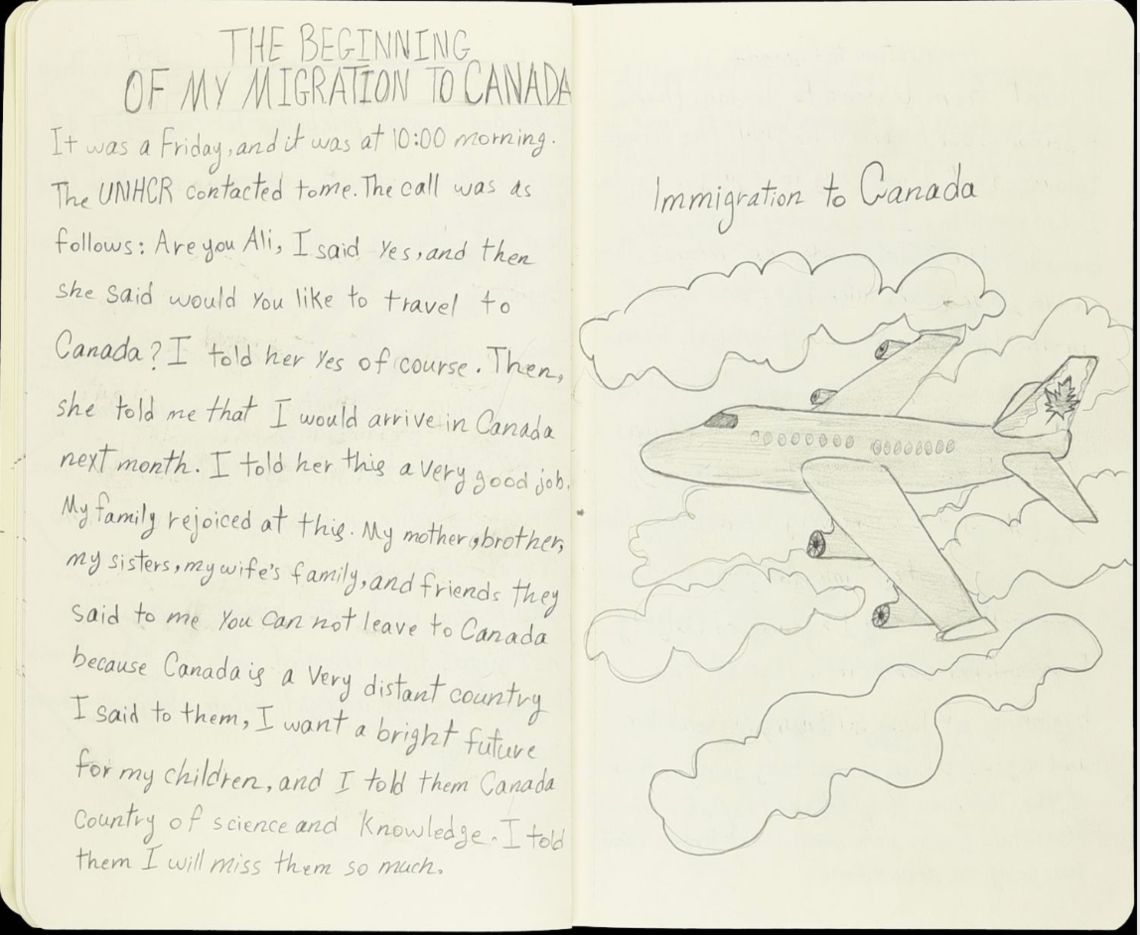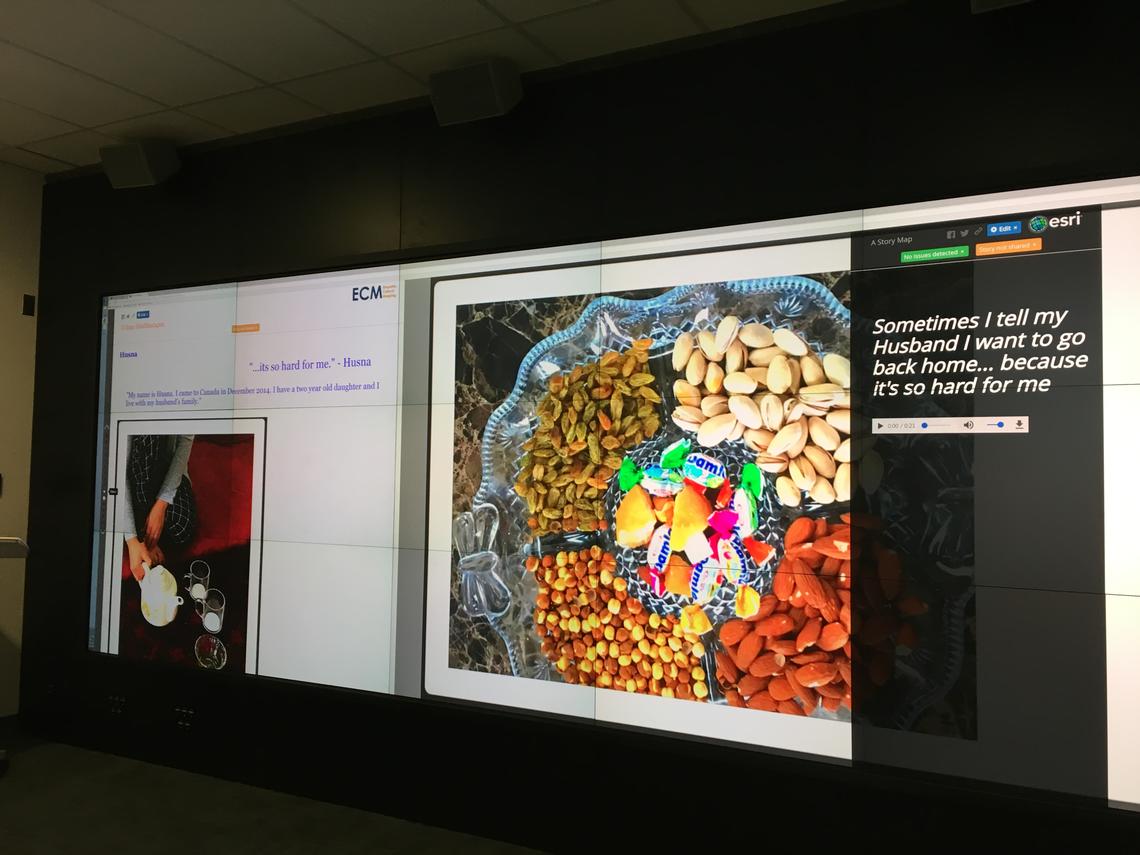May 3, 2018
Nursing researcher's storytelling tool brings together small stories and big data

Big data isn’t just an empty buzzword getting tossed around in the realms of business, health and science. For nursing researcher Suzanne Goopy, large data sets and analysis can actually help us better understand how to create healthy and sustainable cities, but the key is giving context to numbers and examining where statistics meet stories.
Goopy is a visual anthropologist, registered nurse and associate professor in the Faculty of Nursing. She’s exploring the Calgarian newcomer experience and how it’s shaping their daily lives and impacting their health and well-being.
On April 23, she launched the Empathic Cultural Mapping (ECM) project at the Taylor Family Digital Library. It is one of five University of Calgary projects funded by a grant from The Andrew W. Mellon Foundation through UCalgary Libraries and Cultural Resources (LCR).
ECM is an online interactive tool that visually presents big data from sources like Statistics Canada, Calgary Police Service, City of Calgary and other published research findings alongside personal vignettes and stories of six individuals who’ve settled into Calgary. It was developed in consultation with the City of Calgary and community stakeholders.

Eric Thornhill, Suzanne Goopy, Halley Silversides, Cesar Suva, Sally Zhao, and Jonathan Chapman.
Lynda Sea, Faculty of Nursing
“We have been exploring how best to tell the story of the newcomer experience in a way that connects the individual lived experience with big data and mapping analysis,” says Goopy.
For the past few years, she has been working with colleagues across campus from Cumming School of Medicine, Werklund School of Education, Faculty of Environmental Design and with the City of Calgary.
- Goopy and her colleagues are pictured above, from left: Eric Thornhill, research assistant; Suzanne Goopy, associate professor, Faculty of Nursing; Halley Silversides, research assistant; Cesar Suva, program development manager, Calgary Immigrant Education Society; Sally Zhao, CEO, Calgary Immigrant Education Society; and Jonathan Chapman, programs co-ordinator, Liveable Streets Division, City of Calgary.
The team is exploring barriers to walking and mobility for Calgary’s newcomer communities. Their focus is on the South Asian community in Rundle and surrounding communities, as well as recently arrived refugees from countries such as Syria.
ECM is the result, building on data collected through the Barriers to Walkability project. It’s an interactive online tool that brings together various traditional GIS maps (e.g., demographic, community development, transit, and various hotspot maps) to form a new kind — the empathic cultural map.
An empathic cultural map offers detailed, qualitative insights into individual and group experiences of living and working in a particular area. In that sense, with ECM, users can navigate geographical maps on the interactive pages and discover spatial and numeric data, from walkability scores in Calgary neighbourhoods to immigration rates across the globe. But they also encounter audio interviews, scanned journal entries and stories about the new immigrants to Calgary and their personal anecdotes. The juxtaposition encourages users to see links across data which might not always be traditionally evident, with the aim of making connections and seeing key facilitators, blockers or constraints relevant to health.

Throughout ECM, you'll encounter personal stories of new immigrants to Calgary
Lynda Sea, Faculty of Nursing
“By locating small stories within the big data and big data beside the small voices of individuals, I hope the ECM can show us the human implications of things that are often thought of in abstract terms,” says Goopy.
For example, as you navigate through ECM, you’ll come across the story of Ali, who lived in Homs, working as a tile setter before the Syrian civil war. A page from Ali's journal is pictured above. In 2012, he and his family fled to Lebanon and lived there for four years before they were resettled in Calgary in Forest Lawn. They arrived in Calgary in the middle of the winter and didn’t speak English and didn’t own a car. When Ali’s wife and son became ill, they were hospitalized at the Peter Lougheed Centre and the Alberta Children’s Hospital (ACH) respectively, and he had to rely on public transit to visit them.
Goopy’s research team documented Ali’s route, using the YYC transit app and time-lapse video to see what that journey was like from Forest Lawn to ACH. The app proposed it should only take an hour and 10 minutes travel time, but the actual trip took six hours alone, without any visiting time at the hospital.
Forest Lawn to ACH by Transit
“By locating small stories within the big data and big data beside the small voices of individuals, I hope the ECM can show us the human implications of things that are often thought of in abstract terms,” says Goopy.
For example, as you navigate through ECM, you’ll come across the story of Ali, who lived in Homs, working as a tile setter before the Syrian civil war. In 2012, he and his family fled to Lebanon and lived there for four years before they were resettled in Calgary in Forest Lawn. They arrived in Calgary in the middle of the winter and didn’t speak English and didn’t own a car. When Ali’s wife and son became ill, they were hospitalized at the Peter Lougheed Centre and the Alberta Children’s Hospital (ACH) respectively, and he had to rely on public transit to visit them.
Goopy’s research team documented Ali’s route, using the YYC transit app and time-lapse video to see what that journey was like from Forest Lawn to ACH. The app proposed it should only take an hour and 10 minutes travel time, but the actual trip took six hours alone, without any visiting time at the hospital.
“As we learn more about the challenges newcomers face getting around our city on foot and on transit, we are not surprised to hear more than one of our participants tell us that you aren’t a Calgarian until you own a car,” she says. “Knowing that active transportation can have significant positive effects in reducing the incidence of the 'bog four' chronic diseases, it is important that we look for ways to give people more real choices.”
When talking about about health and well-being, it’s impossible to ignore the world around us, the infrastructure and how we live in it day to day. In that way, the highly visual, interactive multi-media platform invites users to take their time to engage, ponder and imagine how big things play out in the small everyday lives of people.

ECM is an interactive tool that brings together traditional GIS maps with the empathic cultural map.
Lynda Sea, Faculty of Nursing
Learn about empathic approach and explore the ECM platform May 3 and 4
Goopy says an empathic approach to understanding these experiences can encourage a more creative pathway to solutions. ECM is significant in that it can help inform actual or future city planning and offers other researchers from different disciplines an educational tool. Going forward, the platform can evolve as new data sets are added accordingly, says Goopy.
ECM is an interactive online tool that brings together various traditional GIS maps (e.g. demographic, community development, transit, and various hotspot maps) with a new type of map — the empathic cultural map.
“We need to have things that people can engage with and that’s at the heart of this,” she adds. Members of the campus community and public are invited to explore the ECM platform on the interactive screens on Thursday, May 3 and Friday, May 4 from 2 to 4 p.m. at the Visualization Studio (466B, 4th Floor) in the Taylor Family Digital Library. Goopy will be present to answer questions and available at the studio on May 4 from 2:45 p.m. to 4 p.m.
To access the Empathic Cultural Mapping tool, click here.
ECM’s interdisciplinary team includes: Suzanne Goopy, associate professor, Faculty of Nursing; Tanvir Turin Chowdhury, assistant professor, Cumming School of Medicine; Gavin McCormack, associate professor, Cumming School of Medicine / Faculty of Environmental Design; Anusha Kassan, assistant professor, Werklund School of Education; Mary Grantham O’Brien, professor, School of Languages, Linguistics, Literatures, and Cultures; Jonathan Chapman, programs co-ordinator, Liveable Streets Division, City of Calgary; Irina Charania, simulation consultant, Cumming School of Medicine; and Carla Ferreira, instructor, Clinical Simulation Learning Centre, Faculty of Nursing. A number of LCR staff have also contributed to the project.
Empathic Cultural Mapping (ECM) is one of five research projects funded by The Andrew W. Mellon Foundation under the unique initiative Academic Research and University Libraries: Creating a New Model for Collaboration. Led by principal investigator Tom Hickerson, vice-provost (Libraries and Cultural Resources) at the University of Calgary, the project is designed to enhance the library’s research platform — a suite of common services, collaborative spaces, and expertise—to support multidisciplinary research by being directly involved with sub-grants to multidisciplinary research teams. Research sub-grants are awarded through a competitive process. Campus scholars will be invited in June to make submissions in the second round of sub-grant proposals.
